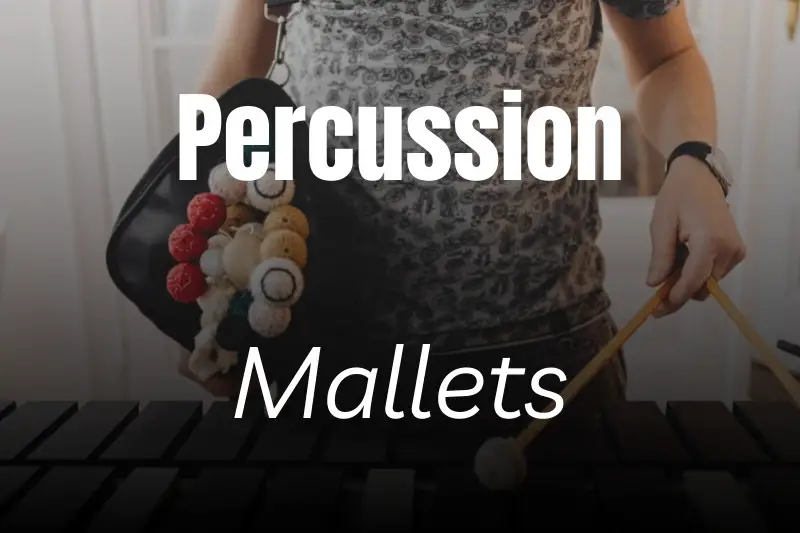Percussion mallets aren’t one size fits all, and anyone who has been playing for more than a few years will be more than happy to show you their collection. Percussionists hoard mallets for fun and practicality. Of course, we have favorites, but having a wide variety ensures we have a pair for every occasion.
Whether it’s solo or ensemble, vibraphone or xylophone, having the right mallets can make or break your performance. We’re going to help you decide which mallets you need from all angles, for which instruments, and in what situations. Keep reading for our ultimate guide to percussion mallets.
Which mallets should I use?
If you’re totally new or know at least a little bit, you might be baffled as you look at the wide array of mallets on the market. Yarn color, handle length, what does it all mean? Which mallets should you use?
Percussion mallets are made with different instruments in mind. The material of the mallet matches the quality of the instrument’s bars. Most mallets with soft, thick yarn in an oval or circular shape will be for the marimba, while rubber mallets with no covering are for xylophone or bells.
If you attempted to play the marimba with a hard plastic bell mallet, not only would it sound awful, but you might also crack the bars. If you played the xylophone with soft marimba mallets, the sound would be very muffled. Having the right tool for the job will make the most of the instrument you’ve decided to play.
Let’s dig in a little deeper into the different kinds of percussion mallets out there before we discuss instruments and which mallets are perfect for them.
Materials for percussion mallets
Percussion mallets come in all shapes and sizes, and that’s a very good thing! The ways you can customize your sound with different types of mallets are nearly endless, which is why experienced players have big bags full of them.
Rubber mallets
Rubber mallets, or unwrapped mallets, are just right for getting a clear, solid strike off of an instrument. Xylophone mallets are typically made of hard rubber. Some marimba mallets can be made of very soft rubber and are used in the higher registers of the marimba.
Yarn mallets
Yarn mallets have a wrapped core, which means they can be any density of rubber covered by a layer of yarn or cord. Marimba mallets and vibraphone mallets come in all different shapes, sizes, and colors of yarn.
The color of the yarn typically corresponds to the hardness of the rubber underneath, and all brands have their own way of color coding.
Plastic mallets
Plastic mallets are used to play the xylophone and the bell lyre or glockenspiel. Players typically just say bells when referring to the bell lyre. Plastic can be very damaging to an instrument that can’t hold up to this material, so reserve this hardness only for bells and xylophones. Plastic mallets have a biting attack when used correctly.
Brass mallets
Brass mallets are another bell-exclusive mallet. The head is typically very small, but they have an incredible sound when used to play the bells. High, bright, and an endless decay, if you ever have the chance to play with brass mallets, enjoy it!
Hybrid mallets
Hybrid mallets are a rare kind of mallet currently made by Malletech. A xylophone mallet for soloists, they have hard rubber cores wrapped with a band of soft rubber. These mallets are excellent for showcasing your ability to go from pianissimo to forte in an instant and dramatically increasing your ability to control the attack. They’re essential for audition season.
In a real-world scenario, you’ll probably be the only percussionist hired on a job, and you’ll have to switch instruments often. Having a mallet that can multitask is critical. Hard plastic mallets are awesome for a xylo to bell switch, and the “two-toned” mallets can go from xylo to marimba with ease.
Why does percussion mallet material matter?
Knowing what material your percussion mallet is made from is critical when it comes to your playing. Why?
As a player, you need to know what your mallets are made from. If you walk into an audition, an ensemble, or a studio, you need to be an expert in your sound.
All three scenarios may call for a different sound, and if you don’t know which mallets to pick to blend in or stand out, you’ll be stuck.
Knowing your instrument is equally as important for all the reasons we’ve stated above. If you’re playing marimba in an ensemble, you might not want to cut through the rest of the group, and if you’re playing a xylophone lick in the studio, you need to be heard.
Let’s move on to picking the best mallets for your situation.
Marimba mallets
Marimba mallets are some of the most fun to pick out when you go shopping due to the absolute rainbow of options you get to look at. They have a few key characteristics, and you’ll need to know how they affect your sound and technique.
Core
The marimba mallet core can be made from soft, medium, or hard rubber. Soft rubber is typically used in lower registers, while hard rubber provides a better sound on upper registers.
Yarn
Marimba mallet yarn can be all kinds of colors and will be either cord, synthetic, or cotton.
Handles
Although it seems like the head would be the most important part of the mallet since it directly affects the tone, the shaft or handle of the mallet is just as important to playing mallet percussion.
Marimba mallet handles can be made from a few different materials such as rattan, birch, maple, or other woods.
Birch and rattan are most common. Rattan is more flexible and gives a nice rebound, while birch wood offers more control on the strike. The preference depends on your mallet grip technique.
I enjoy playing with rattan because it is easier on my hands when playing with Burton grip. Rattan mallets have a little flex to them, so when I’m playing, it keeps my knuckles from absorbing too much shock from the strike.
Xylophone mallets
Xylophone mallets often come bundled as xylo/bell mallets because the materials used have a lot of crossover. Picking a great xylophone mallet early will pay off in the long run. And, a set that can be used on multiple instruments will be a boon as percussionists typically won’t stick to a single instrument during a piece.
Head
The heads of xylophone mallets are typically made of hard plastic or rubber. Generally, hard plastic is the most common, and you can purchase any hardness you like.
Handles
Like marimba mallets, xylophone mallets come in rattan or wood handles. For playing the xylophone, I tend to reach for wood handles because I prefer the precision of the inflexible birch. Only having one mallet in each hand means I don’t have to worry about the shock of the strike.
Vibraphone mallets
Vibraphone mallets happen to be some of my favorite mallets to play with. A nice, heavy mallet head with bouncy rattan handles is just a joy. Vibraphone mallets need to be chosen carefully because the bars of the vibraphone are fragile, but because they’re metal, they’ll chew up your lovely, soft yarn mallets.
Yarn
Pick a cord yarn mallet for vibraphone so your vibraphone mallets will last a long time. Yamaha cautions that softer yarn won’t hold up to play. Vibraphone mallets have a domed, mushroom shape which provides a more definitive strike than ball-shaped marimba mallets.
Core
For vibraphone mallets, it’s nice to have a hard core mallet so your attack will sound out through the ring of the slow decay, even if you aren’t pedaling.
Handles
Most players like to have a rattan handle for vibraphone because it provides some much-needed bounce. You need a little flexibility to play on the metal bars.
Which is better: Burton or Stevens grip?
The last thing we want to touch on quickly is something you’ll come across when you branch out into 4-mallet technique. Entire books could be written about Burton vs. Stevens grip, but we’re going to keep it short and just give you the basics.
Burton grip is played with the mallets crossed across the palm, separated by the index finger. Stevens is played with the second mallet controlled by the ring and pinky finger. Burton allows for more power while Stevens prioritizes range. A versatile musician will use both grips to their advantage.
Since Burton grip is great for playing loud, powerful notes, it’s great for picking out chords in jazz ensembles. Stevens works well on marimbas with graduated bars since you need to reach for a longer range.
Which did you learn when you were studying mallet percussion? Which do you prefer to play? I learned Stevens first since I learned young, and my ring and pinky fingers weren’t strong enough to control the mallet.
Percussion mallet FAQs
Here are some frequently asked questions about percussion mallets.
How long does a mallet last?
A percussion mallet will last a long time if played with good technique. You can keep a pair of marimba mallets or xylophone mallets for years before they need replacing.
Can I fix a broken mallet?
If the handle is cracked, you can tape it pretty effectively, but the fix won’t last forever. Frayed yarn can’t be replaced. Unfortunately, you’ll have to buy new mallets.
Should I learn Burton or Stevens grip?
Young learners should pick up Burton first since it’s easiest to use for basic 4-mallet pieces and not as hard on the hands. Stevens is great to learn, as well, but it’s often not the best to start with.
Percussion mallets: Final thoughts
Learning which percussion mallets to pick is an important part of being a percussion player. And, although you’re going to develop your own personal preferences over time, it’s important to stick to the script while you learn.
Having the right percussion mallets can be the difference between a perfect performance and an auditory disaster.
What do you like to play with? Which brands do you tend towards, and what do you avoid? Let us know in the comments.

